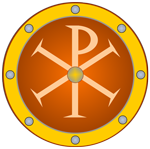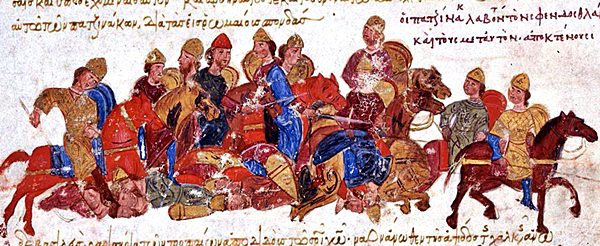
Battle of Diampolis |
year: 1049 |
| Defeat of the Byzantines by the Pechenegs in the first battle of a 5-years war | ★ ★ ★ ★ ★ |
|
enemy: Pechenegs
|
location: Νear the fortress-city Diampolis, modern Yambol (Ямбол) in SE Bulgaria
|
accuracy:
●●●●●
|
|
battle type: Pitched Battle |
war: Pecheneg Wars |
modern country:
Bulgaria |
| ▼ The Byzantines(emperor: Constantine IX Monomachos) | ▼ The Enemies | |
| Commander: | Constantine Arianitis | Unknown |
| Forces: | ||
| Losses: |
| Background story: |
| The Pechenegs or Patzinakae or –very often but incorrectly– Scythians were a nomadic people of Turkish origin, who had migrated west since the 9th century and settled north of the Danube. It is believed to have been one of the 24 tribes that formed the confederation of the Oguz Turks, whose cradle was the steppes around Lake Aral. Other well-known tribes of this group were the Seljuks and the Kumans. In other words, the Pechenegs were Turkomans. They were barbaric but excellent warriors, mostly horse-archers . Occasionally, in the 9th century, they were allies with the Byzantines, who used them against other dangerous enemies, such as the Magyars and the Ros. In 1018, when Basil II overthrew the First Bulgarian Empire, Byzantium was found to be directly bordering the Pechenegs. And then the problems started. Between 1027 and 1045 the Pechenegs made 4 raids on Byzantine lands. The problems intensified after 1043, when under the pressure of the Russians and the Oguz they were forced to move closer to the Danube in search of an opportunity to cross to Moisia (ie northern Bulgaria, which in this period was Byzantine territory). Like most barbarian nomadic people, the Pechenegs were a patchwork of tribes who often fought each other. Around 1046, one of the Pecheneg warlords named Kegenis clashed with the rest, became autonomous and took refuge with the 20,000 of his clan south of the Danube, seeking the protection of the Byzantines, who welcomed him. Kegenis was baptized, honored with the title of patrikios and received large lands and 3 fortresses near Danube. Then he began raids north of the Danube, against the other Pechenegs. In the winter of 1048, the khan of the Pechenegs Tyrach crossed the frozen Danube leading a huge crowd of Pechenegs, which according to Kedrinos reached 800,000 (!). As the Pechenegs advanced south, they were struck by an epidemic and were easily defeated by the Doukas of Adrianople, Constantine Arianitis, with the help of the warriors of Kegenis. Tyrach was taken prisoner. The Byzantines then made the unfortunate choice of accepting the Pechenegs as settlers in the deserted plain of Moisia, aiming, among other things, at using the Pecheneg warriors on other fronts. A key element of the settlement process was the Christianization of the Pechenegs, something that the newcomers did not like very much. Khan Tyrach was “invited” along with 140 other prominent warlords to Constantinople, where they were baptized and given honorary titles, although they were, essentially, hostages. Shortly afterwards, an episode marked the beginning of a five-year war. In early 1049, Emperor Constantine IX Monomachos decided to send a force of 15,000 Pechenegs to reinforce Byzantine forces in Anatolia against a new enemy, the Seljuks. This force, after crossing Bosphorus, revolted and turned back. They headed for Bulgaria, in the area around Sofia where they joined warriors from other Pecheneg tribes and formed a very large horde. Kegenis’ men joined them, as he was very unhappy with the Byzantines, who had imprisoned him unjustly after a slander. The rebellious Pechenegs soon launched attacks in Macedonia and Thrace. Suddenly the Byzantines had to face a new, very serious danger from the north. |
The Battle: |
 Defeat of the Pechenegs by the Ros The Pechenegs, however, were too many, while the Byzantines had probably underestimated them because of the easy win on them under the leadership of Arianitis himself last year. The Byzantine army was defeated and suffered heavy losses. Among the dead were two prominent officers, Theodoros Stravomytis and Polys, who had distinguished themselves in the fight against Tornikos. After the defeat, Arianitis retreated and was fortified in Adrianople. From there he asked for reinforcements from the emperor. |
Aftermath: |
| The emperor arranged for a new army to be sent immediately against the Pechenegs. He also recruited the captive Khan of the Pechenegs Tyrach to whom he promised great rewards if he helped to deal with the problem. The Byzantines, however, were repeatedly defeated in the following years by the Pechenegs, who became a serious problem. |
|
|
